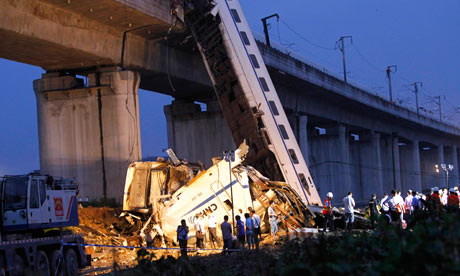July 23 2011: At least 32 people have died after a high speed train crashed into a stalled train in China's eastern province of Zhejiang on Saturday, causing four carriages to fall off a bridge.
Another 200 people have been taken to hospital following the accident which occurred after the first train lost power due to a lightning strike and was then hit from the back by another bullet train following it, according to state television.

A preliminary investigation by the Zhejiang provincial government showed that four coaches of the moving train fell off the viaduct, the official Xinhua news agency reported. The cars plunged about 20-30 metres from the elevated section of track.
Several other carriages were derailed in the accident near Wenzhou, 860 miles south of Beijing. Both trains were headed for the coastal city of Fuzhou; one from Beijing, the other from Zhejiang's provincial capital, Hangzhou.
"The train suddenly shook violently, casting luggage all around," Xinhua quoted survivor Liu Hongtao as saying. "Passengers cried for help but no crew responded."
The total power failure rendered useless an electronic safety system designed to warn following trains of stalled trains on the tracks and automatically halt them before a collision can occur.
Railways minister Sheng Guangzu ordered an in-depth investigation of the accident.
China's government has spent billions of dollars improving the railway network of the world's most populous country and has said it plans to spend $120bn (£73bn) a year over several years on railway construction.
The vast network has been hit by a series of scandals and safety incidents over the past few months. Three railway officials have been investigated for corruption so far this year, and in February Liu Zhijun was sacked as railways minister for "serious disciplinary violations". He had spearheaded the investment drive into the rail sector over the last decade.
The flagship Beijing-Shanghai high-speed rail line has been plagued by power outages, leaving passengers stranded for hours on stuffy trains at least three times since it was opened earlier this month.
The link is the latest and most celebrated portion of a network the government hopes will cover over 28,000 miles by the end of 2015.

No comments:
Post a Comment